



Quick Links: |
Trailers
|
Synopsis
|
Event Details
|
About the Director
|
Post-Film Discussion
|
Themes
|
The Music
|
LADY VENGEANCE
7:30 PM Friday, May 25
Lady Vengeance is the first in a three-film CWC series featuring female protragonists directed by men — Park, Bresson and Dercourt — each bringing unique and exciting perspectives to their work.
Director Park Chan-Wook explores deception, betrayal, vengeance, redemption and the ultimate consequences of revenge in a suspense thriller that is visually stunning, darkly comedic and simultaneously beautiful and horrific. Park employs the baroque strains of Vivaldi and Paganini as counterpoint to what we see on screen, in a truly striking film score.
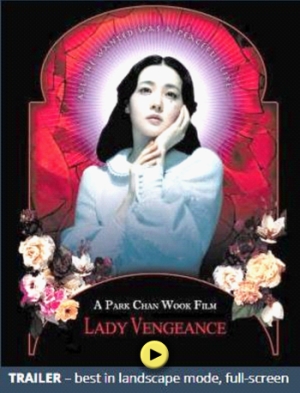 Revenge is a common theme in literature, the theatre and film, but is perceived differently by various world cultures.
Revenge is a common theme in literature, the theatre and film, but is perceived differently by various world cultures.
Describing his film, director Park Chan-Wook cited a major difference between East and West – specifically that in the West, the one who exacts revenge often walks away the hero, contented, satisfied, happy. In the East, he said, the opposite is often the case, with the individual ruined by their acts of retribution.
This persepctive sets the stage for Lady Vengeance.
While revenge is often glamorized in cinema, it quickly becomes clear that this director has other ideas. As the complex and visually stunning story unfolds, Park deconstructs the nature of retribution, moving us to think about the difficult questions raised and the even more difficult solutions. Where many Jacobean revenge plays, and modern films as well, portray the act of revenge as the point of the story, Park Chan-Wook views this as a starting point for further exploration.
Can violence be used as a means for the atonement of sin? Is redemption possible after taking revenge? What are the consequences of violence and revenge? ... These are major themes of the film.
As the story unfolds, the central character, a woman named Geum-ja, believes redemption can be found through retribution. In that regard, Lady Vengeance succinctly underscores what we already know – there is a human tendency to want revenge on an enemy who has brutally wronged you. Dense with pathos and dark humor, the power of the script, performances and cinematic technique pulls the viewer into the story as we consider what we would do given a similar set of hellish circumstances.
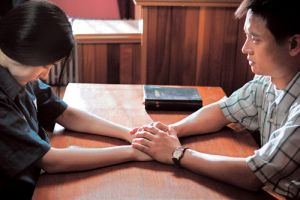
Lady Vengeance can be enjoyed and appreciated for what it is on the surface. But there are many subtleties and much to discover. It's difficult to seriously discuss Lady Vengeance without giving away the ending, but the sections that follow stop short of revealing major spoilers.
Synopsis
Geum-ja has ample reason for revenge. As a pregnant, unmarried teenager, she turned to her teacher, Mr. Baek, for help. Instead, her mentor deceived and betrayed her - involved her in a kidnapping scheme, took her daughter hostage, framed her for murder and saw her imprisoned for his own crime.
A poster girl for religious rehabilitation, Geum-ja is hailed as an angel by an infatuated preacher and his chorus of faithful in Santa Claus suits as she walks out of prison at the end of serving thirteen years for kidnapping and murdering a little boy.
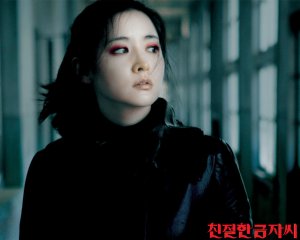
But when beautiful Geum-ja is presented with the traditional white tofu cake meant to celebrate the birth of a new, reformed life, she knocks it to the ground and coldly walks away. The woman who earned a reputation for good deeds behind bars now sets herself on a path of retribution aimed at the man whose criminal acts put her in prison.
On a mission of vengeance, Geum-ja gets a job at a bakery and sets about putting her precise plan into motion. The women she served time with are now out of jail and each of them has an important role to play. Everything is going perfectly when a new wrinkle appears – she finds her long-lost daughter.
Does Geum-ja's quest lead toward redemption or damnation? Is she an avenging angel or a vengeful predator? Will she save those around her or drag them down with her? And will her daughter help her find peace, or be pushed aside for the sake of revenge?

Director Park Chan-Wook explores deception, betrayal, vengeance, redemption and the ultimate consequences of revenge in a suspense thriller that is visually stunning, darkly comedic and simultaneously beautiful and horrific. Park employs the baroque strains of Vivaldi and Paganini as counterpoint to what we see on screen, in a truly striking film score.
 Revenge is a common theme in literature, the theatre and film, but is perceived differently by various world cultures.
Revenge is a common theme in literature, the theatre and film, but is perceived differently by various world cultures.
Describing his film, director Park Chan-Wook cited a major difference between East and West – specifically that in the West, the one who exacts revenge often walks away the hero, contented, satisfied, happy. In the East, he said, the opposite is often the case, with the individual ruined by their acts of retribution.
This persepctive sets the stage for Lady Vengeance.
While revenge is often glamorized in cinema, it quickly becomes clear that this director has other ideas. As the complex and visually stunning story unfolds, Park deconstructs the nature of retribution, moving us to think about the difficult questions raised and the even more difficult solutions. Where many Jacobean revenge plays, and modern films as well, portray the act of revenge as the point of the story, Park Chan-Wook views this as a starting point for further exploration.
Can violence be used as a means for the atonement of sin? Is redemption possible after taking revenge? What are the consequences of violence and revenge? ... These are major themes of the film.
As the story unfolds, the central character, a woman named Geum-ja, believes redemption can be found through retribution. In that regard, Lady Vengeance succinctly underscores what we already know – there is a human tendency to want revenge on an enemy who has brutally wronged you. Dense with pathos and dark humor, the power of the script, performances and cinematic technique pulls the viewer into the story as we consider what we would do given a similar set of hellish circumstances.

Geum-ja has ample reason for revenge. As a pregnant, unmarried teenager, she turned to her teacher, Mr. Baek, for help. Instead, her mentor deceived and betrayed her - involved her in a kidnapping scheme, took her daughter hostage, framed her for murder and saw her imprisoned for his own crime.
A poster girl for religious rehabilitation, Geum-ja is hailed as an angel by an infatuated preacher and his chorus of faithful in Santa Claus suits as she walks out of prison at the end of serving thirteen years for kidnapping and murdering a little boy.

On a mission of vengeance, Geum-ja gets a job at a bakery and sets about putting her precise plan into motion. The women she served time with are now out of jail and each of them has an important role to play. Everything is going perfectly when a new wrinkle appears – she finds her long-lost daughter.
Does Geum-ja's quest lead toward redemption or damnation? Is she an avenging angel or a vengeful predator? Will she save those around her or drag them down with her? And will her daughter help her find peace, or be pushed aside for the sake of revenge?
LADY VENGEANCE
- Director: Park Chan-Wook
- Suspense Thriller, South Korea, 2005, US Release 2006, TRT 112 minutes. In Korean, English and Japanese with English subtitles.
- Dolby Digital, 35 mm, 2.35:1
- Discussion after the film.
- This film is rated R for violent themes and content. For mature audiences only.
- Doors open at 7:00 pm, film at 7:30 pm
- 953 Eden Park Dr, Eden Park/Mt. Adams
- Easy Access, Free Parking ... Directions & Map
- Tickets are $8 for adults and $6 for Art Museum members and students with valid ID.
- $6 tickets are ONLY available online, by phone, at the Museum reception desk, and at the door subject to availability.
- ON-LINE
- tollfree 1-877-548-3237
- at the Art Museum
- Clifton-Ludlow Ave. - Sitwell's Coffee House 513 281 7487
- Mt. Lookout Square - Lookout Joe Coffee Roasters 513 871 8626
- Northside-Hamilton Ave - Shake It Music & Video 513 591 0123
- Covington-Main Strasse - The Bean Haus 859 431 2326 Tickets will also be available at the door, subject to availability.
FRIDAY, MAY 25
CINCINNATI ART MUSEUM
TICKETS
ADVANCE TICKETS:
...and at these locations ($8 tix only, cash only), follow links below for maps:
>>> Watch the Lady Vengeance Trailers (U.S., Korean & Japanese)
Korean filmmakers have risen out of the shadow of Hong Kong cinema, enjoying success on the international circuit. For example, movies such as Shiri, Musa, Save the Green Planet and A Bittersweet Life are frequently seen on 'top ten' lists around the world.
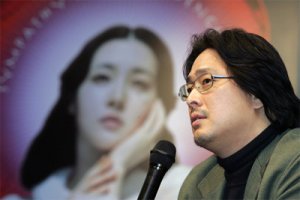 Park Chan-Wook, the director behind such films as Oldboy, JSA: Joint Security Area and Sympathy for Mr. Vengeance has enjoyed more success than most. It can be argued that Oldboy is perhaps the most famous Korean movie of all time outside of its native territory, enjoying rave reviews from pretty much everyone who's seen it.
Park Chan-Wook, the director behind such films as Oldboy, JSA: Joint Security Area and Sympathy for Mr. Vengeance has enjoyed more success than most. It can be argued that Oldboy is perhaps the most famous Korean movie of all time outside of its native territory, enjoying rave reviews from pretty much everyone who's seen it.
"I believe that violence is one of the major forces that moves the world. It is a very fundamental process in everything pertaining to human relationships, and I am very sad to say that this is reality. Therefore, since this is my opinion, it is only natural for me to describe violence in my films, in the same way that other directors, who believe that love makes the world go round, show kisses on the screen."
~ Park Chan-Wook
His portrayal of violence has political roots: Park said in interviews that his quandaries of guilt, anger, and conscience were born during his youth under dictatorship, when friends were dragged off and executed while others, like him, stood by. For now, his films come with a blood-rusted badge of validity and burn with regret.
Non-cinematic influences can be seen in his work, notably Kafka and Dostoevsky, with themes of imprisonment, paranoia and punishment often coming to the fore. Classical Greek tragedy also appears, cunningly mixed with comedy, driven by the undeniable and unavoidable power of fate, and laced together with a bleak and ominous sense of dramatic irony.
The hopelessness and nihilism in his films are often ambiguous, being shocking yet darkly amusing, bringing a sly grin and a touch of gallows humor to the most horrifying situations. Park is a master manipulator in the Hitchcock vein, whose true intentions are difficult to divine.
The level of depth and intricacy we see is perhaps unsurprising, considering that Park actually started out studying philosophy at Sogang University in Korea, exploring the concept of aesthetics with a view to becoming an art critic. Disillusioned by the sparse opportunities offered by his department, he turned to photography to feed his creative urges.
As with many directors, Park discovered his true calling after a cinematic experience – seeing Hitchcock's Vertigo for the first time. Inspired, Park began writing and publishing critical film studies, and upon graduation moved into the industry, getting his first job in 1988 working as an assistant director to Gwak Jae Young on A Sketch of a Rainy Day.
AWARDS & NOMINATIONS
Winner, CinemAvvenire (Cinema of the Future) Award, Venice International Film Festival
Winner, Arca Cinema Giovani Award, Most Innovative Film, Venice International Film Festival
Winner, Young Golden Lion, Venice Film Festival
Winner, Best Director, Bangkok Intl Film Festival
Winner, Best Film, Baek Sang Film Awards
Winner, Best Film, Blue Dragon Awards
Winner, Best Actress, Cinemanila Film Festival Inl Competition
Winner, Best Actress, Sitges Intl Film Festival
Winner, Best Actress, Blue Dragon Awards
Winner, Best Actress, Baek Sang Film Awards
Nominated, Best Asian Film, Hong Kong Films Awards
Nominated, Golden Lion, Venice Intl Film Festival
Nominated, Prix de Screen, European Film Awards
Nominated, Best Film, BBC World Cinema Awards
Nominated, Best Film, Daejong Film Awards
Nominated, Best Director, Daejong Film Awards
Nominated, Best Actress, Daejong Film Awards
Nominated, Best New Actor, Daejong Film Awards
Nominated, Best Production, Daejong Film Awards
Not in Competition:
Official Selection, Toronto Intl Film Festival
Official Selection, New York Intl Film Festival
Official Selection, London Intl Film Festival
Official Selection, Ivy Film Intl Festival Brown University
• Redemption through Retribution
Angel, witch or psychopath? The heroine Geum-ja is a multi-faceted character bent upon retribution who must deal with the emerging doubts about revenge that surface when she is reunited with her missing daughter.
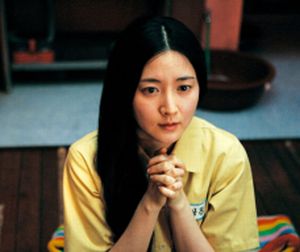 • Consequences
• Consequences Director Park Chan Wook examines many aspects of the concept of revenge, including the most lasting: consequences. Unlike Western films that glorify revenge and ignore the aftereffects, Park conveys a grim, unrelenting picture not only of retribution, but of the consequences it holds for all those involved.
In the second half of the film, LADY VENGEANCE turns to the ethics of revenge, presenting inescapable questions: Can violence be used a means for the atonement of sin? Is redemption possible after such a horrific act? Are individuals (and by implication, mankind) doomed to live by rules such as "an eye for an eye" and "the end justifies the means?"
• Guilt and Atonement
Ever-present in her heart and mind, Geum-ja is burdened by the knowledge that she allowed herself to assist Mr. Baek in his kidnap-for-money scheme, even though she never knew that he would murder the victim. Striving for absolution, Geum-ja meets with the parents of the murdered boy and offers an unusual form of atonement. Later, in the closing chapters of the film, Geum-ja learns a terrible truth about Mr. Baek, adding further to burden of guilt.
• Violence
In his vengeance trilogy, Park is famous (or infamous) for the aura of violence contained in the films, his characters perpetrate evil in order to right a wrong. Although it's true that there is blood and gore in LADY VENGEANCE, this is a much more artistic work here than in Park's earlier efforts. And significantly, most of the violence takes place off-screen, suggesting a desire to draw the focus to the feminine perspective to the revenge motif -- in an honest and thoughtful manner removed from the gratuitous theatrics of films such as Tarrantino's Kill Bill. However, this has a more profound effect than serving up a visual platter of violence for the audience to react to.
Based on the influence of Hitchcock, director Park presents us with the taut expectation of impending brutality, without being overly graphic, avoiding the gory details in favor of studying the actual effects on the characters. LADY VENGEANCE approaches the threshold of any sane viewer on a more psychological and disconcerting level. That said, Park is relatively careful with what he does and doesn't show in the most intense moments, resulting in an impact that is more personal as your imagination effectively fills in the visual blanks.
 • The Transformation of Geum-ja
• The Transformation of Geum-jaWe hear the other characters comment that Geum-ja has changed since they knew her in prison, a warning of what we will learn as the film progresses: Geum-ja is a flawed character, coldly capable of actions most people would find unacceptable.
This is one of the film's most important themes: in the first half of LADY VENGEANCE, we see Geum-ja by way of other people's perceptions. The third-party narratives emphasize her youth and innocence, her kindness and beauty. Which, combined with the comments about changes within Geum-ja, raises the question: Is this the way Geum-ja was or simply how other people remember her? As viewers personalize what they see on-screen, further questions emerge: Is this what can happen to basically good people when extraordinary and horrendous circumstances alter their lives? Could it happen to us?
• The Media
Consistent with the real world, director Park depicts the media in a feeding frenzy when Geum-ja is arrested and presented to the public for a re-enactment of the crime she is accused of. As with O.J., Paris Hilton, et. al., she is elevated to cult status by the media; romanticized primarily because she is beautiful and it seems incredulous that she could commit such an act...
• Religion
References to religion abound, often as comedic relief. The opening scene sets the tone - depicting Geum-ja's release from prison, where she is greeted by a preacher and his flock (dressed in Santa Claus suits!) singing a hymn to a country-western beat. The opening line of dialog, from one of the preacher's group is "They say she is an angel..."
• Rituals
Park includes many societal rituals as sub-text in the film, including cooking, communal meals, prayer, etc.
• Cinematic Oddities – "Fade to Black & White" version
Two versions of the film exist, the standard version and the "Fade to Black & White" version. The latter version begins in full color, but throughout the film the color gradually fades until it is totally black and white at the end of the film, (a cinematic style similar to Robert Rodriguez's Sin City). Park intended the fade to illustrate Lee Geum-ja's progressively colder demeanor and her attempts to reach a stage of purity as she exacted her revenge.
In conjunction with the technique of removing the colors, there is also a change in the environmental colors used in backgrounds, clothing etc. At the beginning of the film, the environments contain a lot of primary colors, whereas toward the end of the film pastel shades, blacks and whites are used. Lee wears a blue coat in the early part of the film, but this is replaced with a black leather coat at the end. The brightly colored walls of the prison and Lee's bedroom are replaced with the grey walls of the school.
Both versions of the film were shown in Korean cinemas, although the fading version was presented only in digital format at a few DLP-equipped multiplexes. This version has since been made available on the Korean Special Edition DVD of Sympathy for Lady Vengeance (with DTS audio only) and in the PAL version of Tartan Films DVD boxset releases of the Vengeance trilogy. On the Tartan boxset packaging, the version is incorrectly titled "Fade to White version".
While LADY VENGEANCE can be enjoyed at top-level as a suspense thriller, if you have read this far you know the film is richly layered with sub-text and societal commentary. It merits discussion of several key areas:
As a function of available time and audience interest, we can also cover the following:
We think your experience will be enhanced by the post-film discussion, which will address these topics as well others the audience may suggest. Please budget some extra time after the film for discussion.
Steven Rosen and David Loy
Steven R. Rosen
A freelance writer formerly based in Los Angeles and now returned to Cincinnati, Steven Rosen has interviewed filmmakers and performing artists and written about film, music and the arts for publications such as the Boston Globe, L.A. Times, Dallas Morning News, Denver Post, Harp Magazine, Paste, Indie Wire and Screen Daily. He was the film critic for the Denver Post from 1997-2002 and before that won a National Music Journalism Award for music commentary. Currently Steve writes about the arts and contributes occasional film reviews to Cincinnati City Beat Magazine.
His film reviews are found at RottenTomatoes.com and these and other writings can also be found online at the following publications: IndieWire, Screen Daily, Cincinnati City Beat, and the Denver Post.
David R. Loy
Conversant with both Buddhist and contemporary Western philosophy, Dr. David Loy has practiced Zen for several decades, trained with Robert Aitken Roshi in Hawaii, completed Zen koan training with Koun Yamada Roshi in Kamakura, Japan, and is qualified as a Zen teacher in the Sambo Kyodan tradition.
He is the author of several books on philosophy and ethics, including: Lack and Transcendence: The Problem of Death and Life in Psychotherapy, Existentialism, and Buddhism, 1996; A Buddhist History of the West, 2002; and The Dharma of Dragons and Daemons: Buddhist Themes in Modern Fantasy, 2004.
Dr. Loy was recently appointed to the Besl Family Chair of Ethics, Religion and Society at Xavier University in Cincinnati. This innovative program focuses on socially significant issues from the perspective of the humanities, literature, philosophy and theology. Previously, from 1985 to 2006, he was professor of comparative philosophy in the International Studies program at Bunkyo University in Chigasaki, Japan, near Tokyo.
While residing in Singapore, 1978 through 1984, Dr. Loy researched, taught and attained a Ph.D. in Philosophy at the National University of Singapore. Prior to attending the University of Hawaii in Honolulu, where he received an M.A. in Asian Philosophy, David began his university work at Carleton College in Minnesota (B.A. Philosophy) with an additional year in England at King's College, University of London, studying analytic philosophy.
David's world view developed at an early age - the son of a Navy man, he was born in the Panama Canal Zone and traveled extensively with his military family while growing up.
The soundtrack, as a stand alone, is very good. And once you've seen Lady Vengeance and note how the music permeates the entire film, the soundtrack will have additional meaning.
The soundtrack CD is titled Sympathy for Lady Vengeance... Music composed by Cho Young-Wook, Choi Seung-Hyun, and Na Seok-Joo, featuring the works of Vivaldi, Alicante/Jordi Savale, and Paganini; performed by the Mo-Ho Baroque Ensemble. Available on Pastel (PMCD 7005); running time approximately 50:00; available from YesAsia.com, catalog number 1004042899: official sound track CD. You can listen to the official sound track on YouTube.
Track Listing:
1. Sympathy For Lady Vengeance (02:26) Adapted from Vivaldi's Cantata "Cessate, Omai Cessate", RV 684 "Ah ch'infelische Sempre"
2. Guemja's Prayer (01:44)
3. None of Your Business (02:46)
4. A Witch (04:44) Adapted from Paganini's Caprice No. 24 in A minor - Quasi presto
5. A Spy (00:56)
6. Fatality (02:40)
7. Sunny Afternoon (01:30) Adapted from Vivaldi's Concerto for Strings in A major, RV 159, Allegro
8. You've Changed (01:31) Adapted from Vivaldi's Concerto No. 3 in G major, RV 310, Largo
9. Marble (02:12)
10. The Angel (01:04)
11. Farewell (00:34)
12. Lullaby (01:49) Adapted from a traditional lullaby (daughter's vocal, in English)
13. The Letter (01:19)
14. Crime and Punishment (01:31) Adapted from Vivaldi's Concerto No. 2 in G minor, RV 578, Adagio e spiccato
15. Pull The Trigger (00:39) Adapted from Vivaldi's Concerto for Bassoon in E minor, RV 484, Allegro
16. Wicked Cake (02:47)
17. Unhappy Party (03:08) waltz
18. Mareta, Mareta No'm Faces Plorar (06:02) Anon, Alicante/Jordi Saval, performed by Montserrat Figueras & Arianna Savall
19. Sympathy For Lady Vegeance (alternate take) (02:21)
20. Lullaby (alternate take) (03:17)
21. Ah Ch'infelische Sempre (05:15)